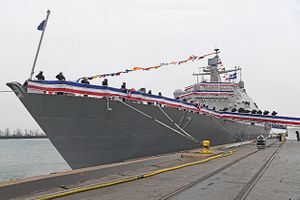The latest Freedom-class littoral combat ship (LCS), the USS Indianapolis, was commissioned into service during a ceremony at Burns Harbor along Lake Michigan in northwestern Indiana on October 26, according to a U.S. Navy statement.
It is the fourth U.S. Navy warship to carry the Indianapolis name. “This Freedom-variant littoral combat ship will continue the proud legacy created by ships previously bearing the name Indianapolis,” Secretary of the Navy Richard V. Spencer said in the statement. “The crew will carry on the tradition of service to confront the many challenges of today’s complex world.”
The Indianapolis was christened in April 2018 at the Fincantieri Marinette Marine (FMM) shipyard in Marinette, Wisconsin and completed acceptance trials on Lake Michigan in July of this year.
The LCS class is composed of the Independence and Freedom variants. Construction of the Freedom variant is spearheaded by Lockheed Martin at FMM. The construction of the Independence class is led by Austal USA in Mobile, Alabama.
Seven other LCSs are in various stages of production and testing at FMM in Wisconsin. The 19th Freedom variant, the future USS St. Louis, is on track to begin sea trials later this year. The Freedom-class variant has a monohull design, while the Independence-class variant features a unique trimaran hull and a larger flight deck capable of carrying two helicopters rather than one. As I noted previously:
[W]ith 40 percent of the hull reconfigurable, both LCS variants use an open architecture design, enabling the warships to be fitted with interchangeable so-called mission packages providing capabilities for surface warfare (SUW), anti-submarine warfare (ASW), and mine countermeasures (MCM) missions in the littoral zone. The ASW warfare package is expected to become available to the fleet in 2019, while the MCM package will be available in 2020.
Next to the different packages, standard armament of a Freedom-class LCS comprises a 11-cell Raytheon RIM-116B SeaRAM missile-defense system, a 57-millimeter naval gun, and Mark 5o torpedoes. LCSs of both variants are also slated to be equipped with the Surface-to-Surface Missile Module (SSMM), a 24-shot vertical launch system designed to engage surface targets with AGM-114L Longbow Hellfire missiles and which is part of the SUW mission package.
“Delays in the development of the SSMM led to the initial deployment of a more limited surface warfare [SUW] mission package aboard the LCS, exchanging Hellfire Missiles for rigid hull inflatable boats and boarding teams,” I wrote in 2017. “The package also encompasses two 30-millimeter machine guns, two MQ-8B Fire Scout unmanned aerial vehicles, and an MH-60S Seahawk helicopter.”
Lockheed Martin has also been working on improving the overall combat capabilities of both LCS variants in a two-phased plan.
The USS Indianapolis will be based at a naval base in Florida.
Notably, one of the ship’s namesakes, the USS Indianapolis, a 9,800-ton Portland-class heavy cruiser, delivered components for the first operational atomic bomb, “Little Boy,” from California to a naval base on the Pacific island of Tinian when the ship was torpedoed by a Japanese submarine on July 30, 1945. Only 317 of the ship’s nearly 1,200 crewmen survived after five days afloat in shark-infested waters in the Pacific.

































